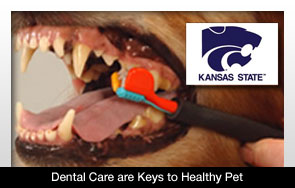 |
When it comes to pet dental care, two Kansas State University veterinarians hope that owners remember an important message: Prevention is always better and often cheaper than treatment.
“Although prevention may be more effort for the owners, it has the best end result for their pets and often their pocketbook,” said Marjory Artzer, a clinical assistant professor at the K-State Veterinary Medicine Teaching Hospital.
By the age of 3, about 80 percent of dogs and 70 percent of cats already have established periodontal disease, said Jennifer Akers, a clinical assistant professor at the Veterinary Medicine Teaching Hospital. Akers said preventative measures are key to identifying and stopping disease before it gets too bad.
Dogs often have more straightforward periodontal disease, ranging from mild cases of gingivitis that can be reversed with cleaning, to more advanced cases where dogs can lose teeth, Akers said. Cats more commonly suffer from issues with tooth resorption and inflammatory disease in their mouth.
Both conditions can be very painful for pets, but animals don’t have to act as if they are pained for disease to exist in the mouth, according to the K-State veterinarians. Often pain comes on slowly, so the animal has time to adjust.
“A lot of times we only know it has been problematic for them after we’ve instituted therapy and they go back to feeling good and have a change in behavior for the better,” Artzer said.
Some signs of dental problems include bad breath, bleeding from the gingiva, changes in eating behavior or pawing and rubbing faces.
Most dental pathology is best identified by a veterinarian, Artzer said, and to help identify any dental problems, owners should make sure their animals get an oral exam every year with their annual checkup.
To help prevent periodontal disease, owners should brush pets’ teeth daily with a pet toothbrush and pet toothpaste. Do not use human toothpaste, Akers said, as it can be toxic to animals. Water-additives, dental chews and dental diets can also help prevent periodontal disease.
“For cats, vigilance in observing and trying to intercede as early in the disease process as possible helps to keep them more comfortable longer,” Akers said. “Daily oral healthcare is important for preventing periodontal disease and also keeps the owners looking in the mouth on a routine basis for signs of problems.”
Owners should not give dogs bones or other hard toys, as they are a common cause of broken teeth.
“With the best intention of providing something that owners may think is OK, it can have a very negative outcome,” Artzer said. “If we provide pets with appropriate toys to chew, that is a better scenario.”
Both veterinarians said owners should start dental care when pets are babies and easily trainable so that they become accustomed to daily toothbrushing. It is especially important for small breed dogs because they are most at risk for periodontal disease.
“Unfortunately, what we see is middle age older pets with really horrible disease in their mouths, and the owners, only in hindsight, wished that they had been doing something about it at a young age,” Akers said.
But with preventative measures, owners can improve their animal’s quality of life and prevent severe complications of periodontal disease, such as complicating factors for heart conditions, kidney problems or other dental diseases.
“Dental care can help pets live a long, happy pain-free life; but no dental care can often lead to very detrimental consequences that can be very painful for our pets and very detrimental for their long-term survival,” Akers said.

|


